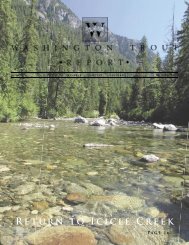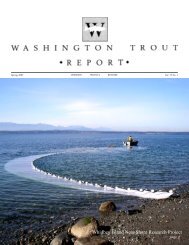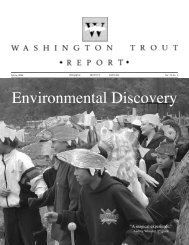Seafood Watch
Pacific Salmon - Wild Fish Conservancy
Pacific Salmon - Wild Fish Conservancy
- No tags were found...
Create successful ePaper yourself
Turn your PDF publications into a flip-book with our unique Google optimized e-Paper software.
<strong>Seafood</strong> <strong>Watch</strong>® Wild Pacific Salmon Report October 8, 2010<br />
negative effects on salmon populations despite mitigation measures, and may be currently<br />
preventing recovery of endangered salmon populations.<br />
Prior to 2002, the Army Corp of Engineers compiled information on the location and distribution<br />
of dams by state. The National Inventory of Dams indicated that in 2001 California had 1,470<br />
existing dams, Oregon 812, Washington 675, Idaho 404, and Alaska just 110 (Figure 1.2)<br />
(USACOE 2002).<br />
Number of Dams by State<br />
Dams<br />
1600<br />
1400<br />
1200<br />
1000<br />
800<br />
600<br />
400<br />
200<br />
0<br />
AK CA ID OR WA<br />
State<br />
Figure 1.2. Number of dams in the U.S. Pacific Northwest and Alaska.<br />
While it is clear that these hydroprojects have been devastating to many fish populations in<br />
North America, and more generally worldwide (Pringle et al. 2000), Chinook and coho salmon<br />
in the contiguous states have been among the most negatively affected. According to one recent<br />
analysis (Dauble et al. 2003), only 13% and 58% of Chinook salmon’s original riverine habitat in<br />
the Columbia and Snake Rivers, respectively, remains, with much of the Snake River habitat<br />
located behind the Hells Canyon dam and therefore inaccessible to salmon. Of the nearly 1,500<br />
km of these rivers once used for spawning by fall Chinook salmon, under 250 km (






